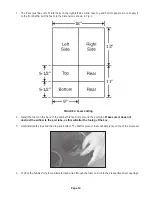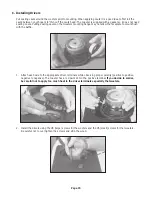
The system impedance and electrical phase is quite smooth, with a nominal 8 ohm impedance. This loudspeaker will
be an easy load to drive for most any amplifier. However due to the 82.5 dB sensitivity, a minimum of 75 watts per
channel is recommended.
The center to center driver spacing is 5-3/4", with the tweeter being offset 1" in a mirror image pair. The tweeter is
flush mounted to the baffle, while the woofer is recessed only to the top of the basket. This was done due to the 5/8"
thickness of the enclosure material.
The Cabinet
The Dayton Audio BR-1
cabinet uses 5/8" thick
MDF and has an net
internal volume of .52
cubic feet. It utilizes a
EBS (extended bass
shelf) alignment and is
tuned to 38 Hz with a rear
mounted port. This tuning
results in a F3 of 43 Hz.
The box dimensions are
8-5/8" wide, 14-1/4" high
with a depth of 11", giving
it a small footprint suitable
for stand mounting. It is
recommended to place
the tweeter at, or slightly
below ear height of a
seated listener.
The center to center
driver spacing is 5-3/4",
which is an important
consideration. When-
ever you have two drivers
combining output, as is
encountered around the crossover frequency there will be some interference patterns. This interference will create
dips and peaks to the frequency response. The greater the distance between the two drivers, the more intense this
undesirable interaction.
The generally accepted maximum center to center distance between the two drivers is equal to one wavelength
(13,560) at the proposed crossover frequency.
Max center to center distance = 13560 / crossover frequency
So in the case of the BR-1:
Max CTC = 13560 / 2100 or 6.45"
Since the tweeter to woofer distance is 5-3/4", the BR-1 is well within the one wavelength tolerance and will provide a
uniform radiation pattern.
Page 9


































